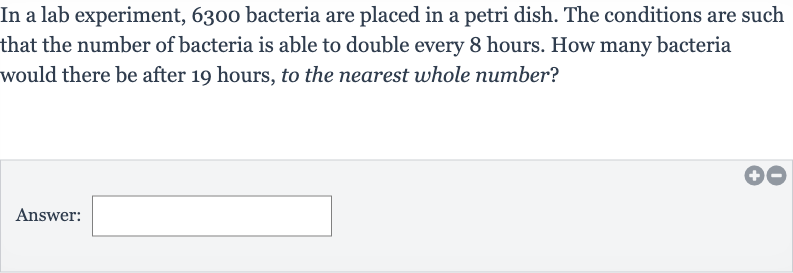AI tutor
Welcome to Bytelearn!
Let’s check out your problem:

In a lab experiment, bacteria are placed in a petri dish. The conditions are such that the number of bacteria is able to double every hours. How many bacteria would there be after hours, to the nearest whole number?Answer:
Full solution
Q. In a lab experiment, bacteria are placed in a petri dish. The conditions are such that the number of bacteria is able to double every hours. How many bacteria would there be after hours, to the nearest whole number?Answer:
- Calculate Doubling Periods: Determine the number of times the bacteria population will double in hours.Since the bacteria double every hours, we divide the total time by the doubling period. hours hours per doubling period = doubling periods.
- Calculate Bacteria After Doubling Periods: Since bacteria can only double a whole number of times, we need to consider only the whole number part of the doubling periods for the calculation.The number of complete doubling periods in hours is (since we cannot have a fraction of a doubling period).
- Calculate Remaining Time: Calculate the number of bacteria after the complete doubling periods.The population doubles times, so we multiply the initial number of bacteria by raised to the power of the number of doublings. bacteria bacteria after hours ( complete doubling periods).
- Calculate Growth During Remaining Time: Determine the remaining time after the last complete doubling period. hours - hours ( complete doubling periods of hours each) = hours remaining.
- Apply Growth for Partial Period: Calculate the growth of bacteria during the remaining hours.Since the bacteria double every hours, we can find the fraction of doubling that occurs in hours by dividing by . hours hours per doubling period = of a doubling period.
- Round Bacteria Count: Apply the growth for the partial doubling period to the bacteria count after hours.We need to multiply the number of bacteria after hours by raised to the power of to find the number of bacteria after the remaining hours. bacteria bacteria after hours.
- Round Bacteria Count: Apply the growth for the partial doubling period to the bacteria count after hours.We need to multiply the number of bacteria after hours by raised to the power of to find the number of bacteria after the remaining hours. bacteria bacteria after hours.Round the result to the nearest whole number, as bacteria count cannot be a fraction.The number of bacteria after hours, rounded to the nearest whole number, is approximately .
More problems from Convert between customary and metric systems
QuestionGet tutor help
QuestionGet tutor help
QuestionGet tutor help
QuestionGet tutor help
QuestionGet tutor help
QuestionGet tutor help
